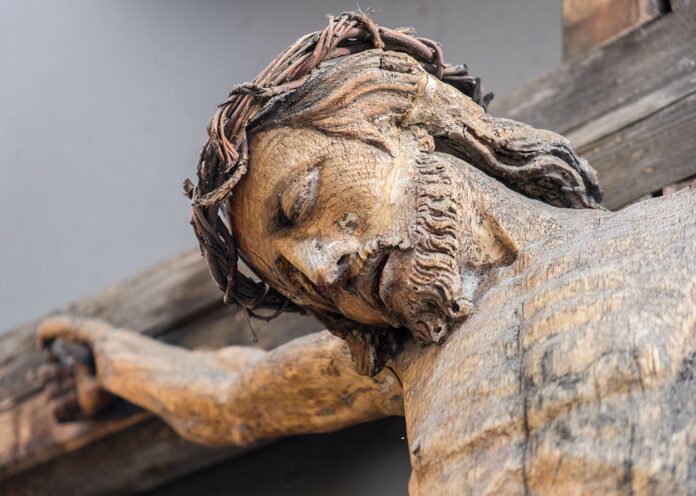I remember once, several years ago, I was on a run with a Protestant friend of mine. He turned to me at a certain point in our conversation and asked, “Why do Catholics keep Jesus on the Cross? He rose from the dead. Why do you celebrate his death instead of his Resurrection?” I do not remember what answer I gave; but I remember very vividly the realization that somehow my friend seemed to consider the Cross something rather distant from the faith of the believer. To him it was part of the mechanism, not the meat, of the faith, the true object of which is the Resurrection of Jesus and our share in it.
I do not disagree that besides God himself the Resurrection must be one of the truest objects of faith, since, as Paul says, if Jesus did not rise from the dead, we Christians of all people are most to be pitied. It is as practically necessary for the integrity of our creed as it is morally necessary for our way of life. However, I received enough of a sacramental imagination from my upbringing to see then as well as now that if the Resurrection has meaning in every moment of my life—that is, if, as a historical event, it changes the meaning of my own actions now and demands from me a living response to it two thousand years later—then the Cross also must be the sort of event to which my life returns and about which all my actions must revolve. If the empty tomb is the touchstone of human history because it announced the death of Death, the Cross is the same touchstone because it slew death. The triumphant entrance of St. George into the liberated city may be the most glorious moment in the story, but no one who wishes to imitate St. George thinks first of his triumph, unless he is deluding himself. It is the fight against the dragon that must be imitated, the desperate duel with death that must arouse the old piety of the sword. I think this explains in some way how my immediate and imaginative response to the Cross was so different from my friend’s, even though we believe in the same reality and hope for the same eschaton.
The question of the Crucifix, however, is not about the order of events in Christ’s life (i.e., the Cross came before the empty grave), or about the facticity of the Cross, or indeed about the eschaton. It is not enough to say merely that one cannot believe in the Resurrection without believing in the Cross. My friend did believe in the Cross, only he saw it as an event that has no meaning or value except through the Resurrection, and which therefore is useless and even repulsive as an icon. In other words, there could be no theology of the Cross that was not essentially a theology of the Resurrection: therefore it is altogether backwards to set up the Cross as the primary symbol of Christian hope. For my friend, only the empty Cross could be a symbol of hope. For him, the more theological the Cross becomes, the more invisible it becomes. The difference between the two of us, however, was mainly one of perspective. I think we had fundamentally similar theologies of the Cross (the main difference being, as I think, its sacramental dimension). My friend could not conceive of the veneration of the Cross, and I could not conceive of hope without the Cross. For him it was a symbol of the power of sin; for me, the power of the love of God.
This is the paradox of the Cross, that at the very moment sin appeared to have all power and Satan appeared to have made a mockery of our Lord once and for all, sin in fact lost all its hold on man and Satan realized that all mortal hatred is futile—even (oh horror!) useful in the face of the love of God. In this sense, the Cross cannot represent the power of sin without representing at the same time the utter powerlessness of sin.
For if we do take the Crucifix as a symbol, what does it mean? Is it a reminder of an event, like a photograph of a baby at its birth, or a portrait of a gentleman? Truly it is a reminder, but its symbolic meaning is not the expression of mere data, i.e., that Christ was tortured to death. Symbolically, it is the image of perfect love. This can be understood in two ways. First, it is exemplary love, and therefore exemplary life. When Christ tells us to take up our crosses and follow him, we can see what he means in his Cross. We are told to be like our Master, and “greater love has no man than this, that a man lay down his life for his friends” (John 15:13). Thus the Crucifix is the pattern for life in Christ.
Second, it is profound comfort. What is of more comfort to the suffering than that Christ shared in it; or to the condemned that he accepted our condemnation too; or to the oppressed than that he stood in our oppression and allowed the powers of the world to inflict their worst torture on him? By the testimony of the Holy Spirit through the Apostles, we believe in the Resurrection of Christ, and therefore we do not fear for him when we look at the Cross. Jesus said, “I have power to lay [my life] down, and I have power to take it again; this charge I have received from my Father” (John 10:18). But when he looks down on us from the height of that terrible tree, we do not even need to fear for ourselves, because there in the battle for all mankind he is with us and for us. When we are adrift on the sea of death, powerless and afraid for our lives, Jesus comes to us on the Cross and says, “It is I; do not be afraid” (John 6:20). Thus no matter where we look, we see the loving face of Jesus, even when we see nothing but oppression and death. If crosses were the symbol of the oppression of the world, the Crucifix has become the symbol of the friendship of God.
My Father calls me onward into battles I cannot win, but Christ my brother goes before me, and the victory is already his. The banner he waves confounds the enemy, though it bears the sign of the very weapon that spread terror and death across the Roman Empire.
“For Jews demand signs and Greeks seek wisdom, but we preach Christ crucified, a stumbling block to Jews and folly to Gentiles, but to those who are called, both Jews and Greeks, Christ the power of God and the wisdom of God. For the foolishness of God is wiser than men, and the weakness of God is stronger than men” (1 Cor 1:22-25).Therefore, as Constantine saw in his dream on the eve of his victory, in words glittering across the sky, in hoc signo vinces, “in this sign you will conquer.” And he saw in the heavens not the tomb but the Cross.






